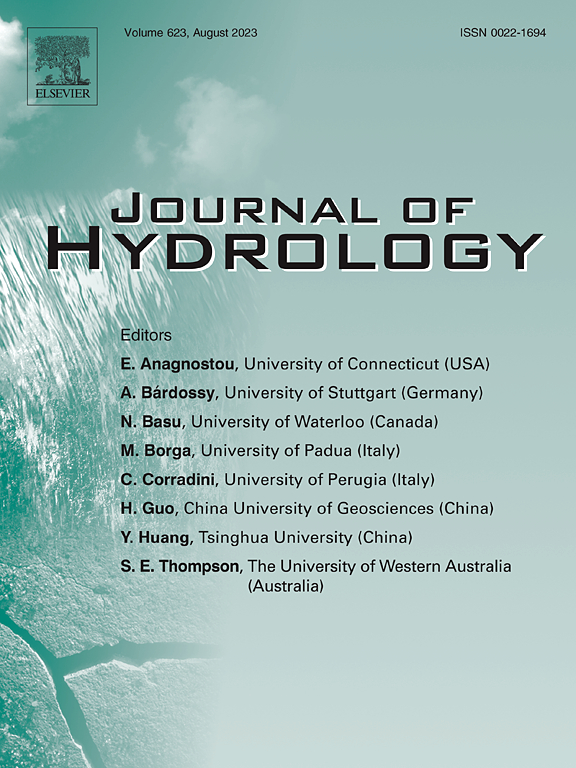基于新型混合模型的非线性非平稳环境径流精确预测
IF 5.9
1区 地球科学
Q1 ENGINEERING, CIVIL
引用次数: 0
摘要
准确的径流预测对水资源管理和生态保护至关重要。然而,径流过程的非线性、非平稳性和多尺度性阻碍了预测精度的提高。为了应对这些挑战,本研究提出了一种名为OVMD-IAPO-TCN-GRU的新型组合预测模型,该模型集成了优化变分模态分解(OVMD)、改进的北极海雀优化算法(IAPO)以及结合时间卷积网络(TCN)和门控循环单元(GRU)的深度学习神经网络。模型的框架优化并增强了每个组件的功能。首先,采用IAPO算法对VMD的关键参数进行优化,从而有效地分离不同时间尺度的水文过程。这一步骤显著提高了非平稳径流序列的分解质量,减少了特征提取中的模态混叠和失真。随后,分解良好的非光滑径流数据由TCN- gru模块处理,该模块利用门控循环单元捕获长期依赖关系,而TCN组件则改进了重要多元时间序列特征的提取。此外,采用IAPO算法对TCN-GRU参数进行进一步微调,增强了模型对非线性关系的拟合能力,提高了模型的泛化性能。OVMD-IAPO-TCN-GRU模型将分解得到的每个平滑子序列与提取的最优特征相结合,通过叠加每个模型的预测结果,提供准确的径流预测。IAPO算法通过引入有效的初始化策略和更新行为转换因子,增强了北极海雀算法的优化能力,提高了参数优化精度。在洪家渡和映洛峡两个地点进行了实例研究,验证了模型的有效性。使用4个评价指标、9个基准模型和4个高级组合优化模型对性能进行了评估。结果表明,该模型的Nash-Sutcliffe效率系数(NSEC)和相关系数(R)均超过0.96,在所有指标上均优于比较模型。具体而言,与TCN-GRU模型相比,均方根误差(RMSE)分别降低了66.29%和64.73%。这些发现突出了该模型在不同流域高效、准确的径流预测方面的巨大潜力,强调了其在径流预测方面的优越性。本文章由计算机程序翻译,如有差异,请以英文原文为准。
Accurate runoff prediction in nonlinear and nonstationary environments using a novel hybrid model
Accurate runoff prediction is essential for water resource management and ecological conservation. However, the challenges posed by the nonlinear, non-stationary, and multiscale nature of runoff processes hinder the achievement of high prediction accuracy. To address these challenges, this study proposes a novel combined prediction model named OVMD-IAPO-TCN-GRU, which integrates optimized variational modal decomposition (OVMD), an improved Arctic Puffin Optimization Algorithm (IAPO), and a deep learning neural network that combines temporal convolutional networks (TCN) and gated recurrent units (GRU). The model’s framework optimizes and enhances each component’s functionality. Initially, the IAPO algorithm is employed to optimize the key parameters of the VMD, thereby effectively separating hydrological processes across various time scales. This step significantly improves the decomposition quality of non-stationary runoff sequences, reducing modal aliasing and distortion in feature extraction. Subsequently, the well-decomposed non-smooth runoff data is processed by the TCN-GRU module, which leverages gated recurrent units to capture long-term dependencies, while the TCN component improves the extraction of significant multivariate time-series features. Furthermore, the TCN-GRU parameters are further fine-tuned using the IAPO algorithm, thus enhancing the model’s ability to fit nonlinear relationships and improving its generalization performance. Combining each smoothed subsequence obtained from decomposition with the optimal features extracted, the OVMD-IAPO-TCN-GRU model delivers accurate runoff predictions by superimposing the predictions from each mode. The IAPO algorithm enhances the optimization capabilities of the Arctic Puffin algorithm by introducing effective initialization strategies and updating behavioural conversion factors, which improves parameter optimization accuracy. Case studies were conducted at the Hongjiadu and Yingluoxia sites to validate the model’s effectiveness. The performance was assessed using four evaluation metrics, nine benchmark models, and four advanced combined optimization models. The results indicate that the proposed model achieves a Nash-Sutcliffe efficiency coefficient (NSEC) and correlation coefficient (R) exceeding 0.96 and outperforms comparison models across all metrics. Specifically, the root mean square error (RMSE) is reduced by 66.29% and 64.73% compared to the TCN-GRU model. These findings highlight the model’s significant potential for efficient and accurate runoff prediction across different watersheds, emphasizing its superiority in runoff forecasting.
求助全文
通过发布文献求助,成功后即可免费获取论文全文。
去求助
来源期刊

Journal of Hydrology
地学-地球科学综合
CiteScore
11.00
自引率
12.50%
发文量
1309
审稿时长
7.5 months
期刊介绍:
The Journal of Hydrology publishes original research papers and comprehensive reviews in all the subfields of the hydrological sciences including water based management and policy issues that impact on economics and society. These comprise, but are not limited to the physical, chemical, biogeochemical, stochastic and systems aspects of surface and groundwater hydrology, hydrometeorology and hydrogeology. Relevant topics incorporating the insights and methodologies of disciplines such as climatology, water resource systems, hydraulics, agrohydrology, geomorphology, soil science, instrumentation and remote sensing, civil and environmental engineering are included. Social science perspectives on hydrological problems such as resource and ecological economics, environmental sociology, psychology and behavioural science, management and policy analysis are also invited. Multi-and interdisciplinary analyses of hydrological problems are within scope. The science published in the Journal of Hydrology is relevant to catchment scales rather than exclusively to a local scale or site.
 求助内容:
求助内容: 应助结果提醒方式:
应助结果提醒方式:


